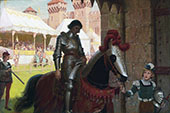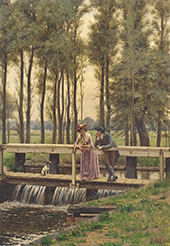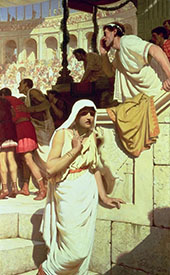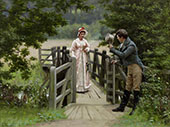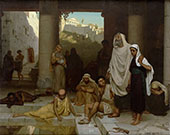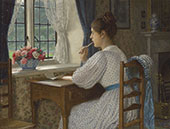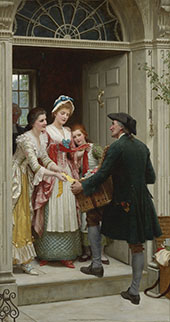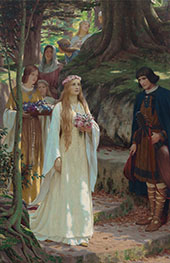Genre Oil Painting Reproductions
Find Genre oil painting replicas by Genre artists
Genre Painting: A Brief Introduction
Genre painting typically illustrates scenes of everyday life, with ordinary people engaged in routine activities. They can be intensely realistic, entirely imagined, or heavily romanticized by the artist.
Because of their everyday subject matter, Genre paintings exploded in popularity with the upper-middle classes during the 17th century. While this trend appeared in the Netherlands, its influence spread throughout Europe. This brief introduction explores famous Genre paintings and the movement's pioneering artists. Genre paintings are some of our most popular oil painting reproductions.
What is Genre Painting?
Paintings that include commonplace subjects and everyday scenes are Genre paintings. These settings might be domestic households, urban streets, or rural locations.
Genre painting definition: a quick guide
The style first appeared in Holland in 17th century art when showing peasants at work or having fun, typically while drinking in bars, was typical. William Hogarth popularized the style in Britain with several narrative artworks. A Rake's Progress is one of the most famous Hogarth series.
Genre painting also saw a resurgence in the Victorian paintings. Oil paintings by Charles West Cope and Harold Knight are emotional artworks that often feature sentimental family scenes. In Italy, Angiolo Tommasi painted beautifully colorful paintings of peasant life and moving portrayals of emigration and poverty.
This later generation of Genre painters tried to capture the energy and transience of modern industrial life in Europe's main cities. Gradually, this developed into Impressionist oil paintings and Post-Impressionist styles. Famous paintings by Pierre-Auguste Renoir and Edouard Manet exemplify this trend with their sparkling street scenes and cafe interiors.
It is important to remember that the term "genre" can also apply to various hierarchies of oil painting. Examples of "genres" of art include history paintings, portraits, landscapes, and Still Life oil paintings.
Why is it called the Genre Art Movement?
Genre is a French word that means "variety" or "kind." From the late 18th century onwards, French writers described artworks depicting everyday life as genre painting.
This style differed from History painting, featuring rural scenes and working environments. While History paintings always included some narrative or moralizing elements, Genre paintings showed simple everyday scenes without necessarily having an additional moral message.
What are the four genres of painting?
The four "highest" genres of painting are:
● Landscape
● Portraiture
● Genre-Scenes
● History
Art Historians have debated the relative significance of these categories for centuries. Many people would also include Still Life as a fifth genre. Indeed, the art theorist Andre Felibien, Secretary to the French Academy, officially named these five genres in 1669.
This method of "ranking" artworks according to subject matter first appeared during the Italian Renaissance. It borrowed from Greek and Roman hierarchies of art.
The great art academies of Europe, such as the Academie Julian in Paris and the Royal Academy in London, also furthered this hierarchy. These hierarchies remain influential today, with landscapes and portraiture works often fetching the highest prices at auction.
What are examples of genre paintings?
While Genre paintings appeared all over Europe, Dutch Genre paintings are the most famous and earliest examples.
Here are three examples of Genre painting, showing its fascinating development throughout the centuries:
1. Bruegel Hunters in the Snow
Hunters in the Snow by Pieter Bruegel, the Elder is one of the earliest examples of Dutch Genre painting. As an oil-on-wood artwork, it shows hunters and their dogs returning after an unsuccessful winter hunt.
A fox corpse is the hunters' only prize. An escaped rabbit's (or hare's) footprints are visible in the snow.
While this painting also represents the European "Labors of the Months" tradition, it perfectly exemplifies Genre-based depictions of rural activities throughout the year.
2. Johannes Vermeer, Girl Asleep at a Table 1657
Johannes Vermeer's Girl Asleep at a Table depicts a domestic servant sleeping beside a half-drunk glass of wine.
Vermeer explores painterly color, texture, and light themes with this simple subject matter. However, he doesn't present a moralizing lesson, unlike many Dutch artists. Instead, Vermeer shows an everyday domestic scene with intense realism.
Curiously, X-radiographs (from the Metropolitan Museum of Art in New York) revealed how Vermeer removed a man painted in the open doorway. This erasure only heightens the painting's mystery and intrigue.
3. Francisco Goya, Two Men Eating Soup 1823
While Genre painting emerged from the Netherlands, Spanish artists soon adopted the style. Indeed, Flemish art was popular in Spain, partly due to Spain's earlier rule over the Netherlands.
The Spanish Golden Age started in the seventeenth century. Artists like Diego Velazquez painted city life and kitchen scenes during this time. Later, artists like Francisco Goya experimented with Genre painting to comment on the human experience.
Two Men Eating Soup is one of fourteen Goya Black Paintings created during his final years. Francisco Goya became deeply disillusioned with humanity and the world by this point. This image depicts two hunchbacked figures painted in grays, blacks, and yellows. While the man on the left smiles ominously while clutching his soup spoon, the character on the right barely seems alive.
Who are English and French Genre painters?
In addition to these three examples of Genre painting, the English artist William Stott and the French painter Auguste Toulmouche are also worthy of mention.
With works such as The Ferryman 1881, Stott showed the intense creative collaboration between English and French artists at the time. Reflecting a ferry crossing at Grez-sur-Loing, in North-Central France, it is a beautifully calm representation of quiet, country life. Today, the work hangs in Tate Britain.
Auguste Toulmouche created many images of middle and upper-class Parisian women representing a more luxurious approach to Genre paintings. Popular with the French Academy, these artworks all featured women in domestic scenes engaged in everyday activities. Reading Lesson and The Reluctant Bride exemplify his sumptuous settings and beautiful inhabitants.
Buy Genre Paintings
Fine art reproductions are for sale with a choice from thousands of famous oil paintings. With some of the most famous examples of Dutch Genre painting, you'll discover stunning masterpieces to adorn your walls.
Explore our extensive collection of replica art from Renaissance oil paintings to Old Masters Paintings. In addition, we offer colorful wall art for the most discerning art lover.
Cannot Find What You Are Looking For?
Reproduction Gallery Information
Customer Service
(Send Us A Message)
Tel: (503) 937 2010
Fax: (503) 937 2011







